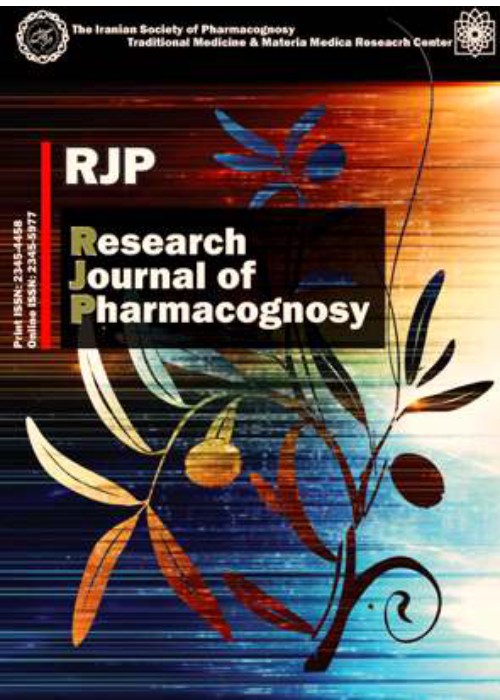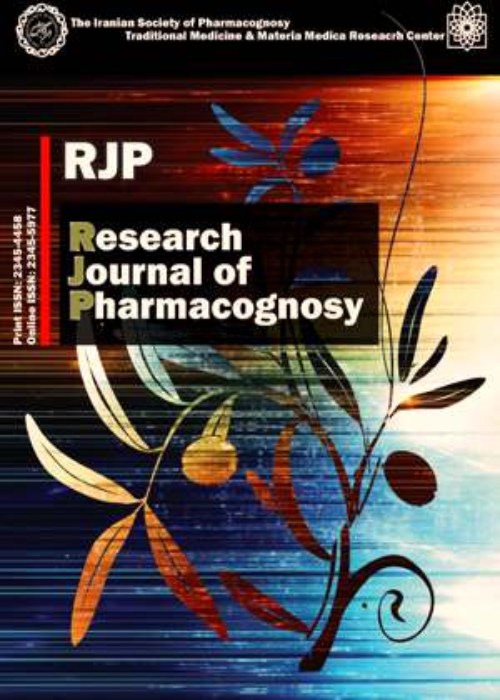فهرست مطالب

Research Journal of Pharmacognosy
Volume:10 Issue: 1, Winter 2023
- تاریخ انتشار: 1401/10/03
- تعداد عناوین: 8
-
-
Pages 1-4Background and objectives
Pharmacognostic evaluations have paved the way for compilation of African Pharmacopeia. This study reports the pharmacognostic profile of Maesobotrya dusenii (Pax) Pax and Maesobotrya barteri (Baill.) Hutch.
MethodThe two plants were collected from the Etche Area of Rivers State. Macroscopic and microscopic evaluations of the stomata number and palisade numbers were done. Phytochemical screening was conducted using standard methods and physicochemical parameters were evaluated to determine moisture content, extractive values and ash content. The flavonoid content of M. barteri was also evaluated using quercetin equivalent.
ResultsMaesobotrya dusenii revealed anomocytic type of stomata while M. barteri showed a mixed type of stomata involving anomocytic and anisocytic. Phytochemical screening revealed the presence of triterpenoids, saponins and carbohydrates in M. dusenii, while in M. barteri flavonoid, cardiac glycosides, saponin, triterpenoids and alkaloids were present. Maesobotrya dusenii and M. barteri showed the highest extractive value by chloroform.
ConclusionThe study revealed distinctive features between M. dusenii and M. barteri that can be used in their identification, authentication and preparation of monograph for the plants.
Keywords: Flavonoid content, Maesobotrya, palisade, Stomata -
Pages 5-14Background and objectives
We wanted to figure out how pharmacists make their judgments about the efficacy of natural products in urolithiasis and how they make suggestions about these products.
MethodsA self-made descriptive questionnaire was designed, evaluated, and performed to assess pharmacists’ knowledge, attitude, and practice (KAP) about natural products in urolithiasis in 46 young pharmacists and final year pharmacy students in Shiraz.
ResultsIn all of the KAP sections, Rowatinex®, Cystone®, and Sankol® were the most known, believed to be effective, and preferred pharmacist products. Respondents had received different education hours. About 54% of them believed their education was averagely adequate. Brochures (63.0%), web-search (60.9%), and applications (45.7%) were the primary resources used by pharmacists, mainly to check the instruction of use. About 80% of pharmacists were unaware of the mechanism of action of at least 5 of 14 products. Generally, respondents had a positive view of natural products. In addition, they thought price and advertisements were effective in patients’ and physicians’ choice of products. More than half of pharmacists preferred to use clinical trials (52.2%) rather than systematic reviews (19.6%).
ConclusionProviding a vast amount of information in the education process is not the best solution for preparing pharmacists for their role in community pharmacies. Besides the need for increasing clinical trials about complementary and alternative medicines and developing evidence-based databases, we need to train pharmacy students in professional ways to gain knowledge about complementary and alternative medicines.
Keywords: Complementary Therapies, evidence-based pharmacy practice, kidney calculi, Pharmacy education, Questionnaire -
Pages 15-22Background and objectives
Hot flash is one of the most common problems in post-menopausal women. The usual treatment is hormone therapy with estrogen and progesterone, which presents side effects such as heart attack, cancer, and depression. In Iranian traditional medicine, some prescriptions have been recommended for treatment of hot flash; in the present study, a syrup was formulated based on traditional medicine and the efficacy in hot flash was evaluated in a pilot study in post-menopausal women.
MethodsFoeniculum vulgare (fennel) and Melissa officinalis (lemon balm) were used for preparing the syrup. Physicochemical and microbial quality control tests were performed and the syrup was standardized based on rosmarinic acid and total phenolics content. The effect in post-menopausal women was evaluated in a pilot study with Carpenter Hot Flash Related Daily Interference Scale questionnaire.
ResultsThe results of the quality control and accelerated stability tests after six months were in agreement with the acceptance criteria. The pH, density, viscosity, dry residue, total phenolics and rosmarinic acid contents were 5.29, 1.12 g/cm3, 42.15 cP, 43.43, 4 mg/mL (as pyrogallol) and 1.28 mg/mL, respectively. In the pilot study, the number and intensity of hot flash decreased (p<0.05); however, there were no significant differences between the number and intensity of night sweating before and after the intervention (p>0.05).
ConclusionConsidering the promising effect of the formulated syrup on hot flash and the acceptable quality and stability of the product, it can be suggested in larger clinical trials for confirming the efficacy.
Keywords: Foeniculum vulgare, Hot flash, HPLC, Melissa officinalis, menopause -
Pages 23-29Background and objectives
Propolis is a natural product of honey bees that is characterized by therapeutic effects on diverse diseases. To elucidate the molecular mechanism of propolis effects on tumor, protein-protein interaction (PPI) network analysis of proteome data of Hep-2 cells treated with red propolis was conducted.
MethodsCytoscape V 3.9.1 and its plug-ins evaluated the differentially expressed proteins (DEPs) in terms of network construction and the corresponding topological features.
ResultsThe results implied that six hub-bottlenecks including ACTB, GAPDH, HSP90AA1, HSPA8, HSP90AB1, and HSPA5 were present in the PPI network; however, only the last central protein was among DEPs. ClueGO+ CluePedia identified five related biological processes and three action types of their connections. Results refer to anticancer property of red propolis.
ConclusionThe proposed crucial proteins and their linked biological processes may represent as key players in the anticancer underlying mechanism of red propolis.
Keywords: Biological process, cancer, Network analysis, propolis, therapeutic -
Pages 31-40Background and objectives
During health crises like COVID-19, people with different health conditions turn to traditional/herbal remedies, which can affect their health status. This study aimed to determine medicinal plant consumption and its association with health literacy during the COVID-19 pandemic in Iran.
MethodsThis web-based cross-sectional study involved 1242 Iranians aged 18 to 65. Data were collected using the Iranian Health Literacy Questionnaire (IHLQ), COVID-19-related variables, and a socio-demographic information questionnaire, analyzed by simple and multiple logistic regression analyses using SPSS 16.0.
ResultsIt was found that 51.4% (n=638) of participants had used medicinal plants and herbal products, with a mean Health Literacy (HL) score of 76.16. Thyme (50.6%), ginger (34.9%), and cinnamon (24.4%) were the most commonly used plants; the most popular methods were infusion (78.3%) and decoction (32.2%). According to the adjusted analysis, the use of medicinal plants was significantly associated with being older (odds ratio (OR)=1.85, 95% confidence interval (CI):1.14-3.00), having contact with suspected/confirmed COVID-19 cases (OR=1.94, 95% CI:1.39-2.71), and having family members, friends, and/or relatives infected with COVID-19 (OR=1.37, 95% CI:1.00-1.88). Also, people who consulted with a physician or pharmacist before using medicinal plants had statistically higher mean HL scores than those who did not (p<0.001), as do those who consider potential interactions with other medications or medicinal plants (p<0.001).
ConclusionConsidering that at least half of the people used medicinal plants during the COVID-19 outbreak, providing accurate information by regulatory organizations on medicinal plants, their potential side effects, and interactions, especially during times of crisis, seems to be urgent.
Keywords: COVID-19, Health literacy, Iran, Medicinal plant, plant preparations -
Pages 41-50Background and objectives
Hot flashes are one of the most predominant complaints of menopause among women. The main treatment is hormone replacement therapy, which has side effects. Therefore, the use of plants with phytoestrogen has been suggested as an adjunctive treatment. This study aimed to estimate the efficacy of processed rhubarb (Rheum ribes L.) on hot flashes in postmenopausal women.
MethodsThis double-blind placebo-controlled trial was performed on postmenopausal women who were referred to public health centers at Iran University of Medical Sciences. Ninety postmenopausal women aged over 45 years with menopausal hot flashes were randomly assigned to two groups. The treatment group received 500 mg of encapsulated processed R. ribes twice a day for eight weeks, and the control group received placebo (starch powder) in the same manner. Data were collected using Blatt–Kupperman index at the start of the study, fourth and eighth weeks after the intervention. Descriptive and analytic statistics were used to analyze the data.
ResultsA total of 74 patients completed the study (39 participants in the intervention group and 35 in the control group). The results showed that R. ribes significantly decreased the mean of flashing in Blatt–Kupperman index four and eight weeks post-intervention (p<0.001). Rheum ribes showed no serious adverse effects.
ConclusionThe findings of this study propose that treatment with R. ribes may be considered an adjunctive treatment for hot flashes in postmenopausal women.
Keywords: Herbal medicine, Hot flash, menopause, Rheum ribes -
Pages 51-56
Although Verbesina crocata (Cav.) Less. is commonly used in Mexico as a medicinal plant to treat numerous disorders (a tradition dating back to pre-Hispanic times), scant scientific evidence exists on its pharmacological activity. The current review compiles information on the botanical characteristics, traditional medicinal use, and scientific evidence of the pharmacological effects of V. crocata with the aim of orienting future research. This narrative review searched for information on V. crocata with the key words “Verbesina crocata” and its local name “Capitaneja” from the following databases: PubMed, Scopus, EBSCO, SciELO, ScienceDirect, and Google Scholar. Few studies were found about the therapeutic effects of V. crocata in experimental animal models. Empirical knowledge of the effects of preparations predominated over scientific evidence. Among the diverse medicinal applications of V. crocata in Mexico, only its wound healing, antidiabetic, and diuretic activity have been tested scientifically. Little is known about the active constituents of the plant and less about their mechanisms of action or toxicity. Terpenes/steroids, glycosides, alkaloids, coumarins, quinones, saponins, and tannins have been identified as potentially responsible for therapeutic effects. The information available on V. crocata is predominantly empirical. The few scientific reports on its biological activity have confirmed the efficacy of the plant as a wound healing agent, antidiabetic, and diuretic. It is necessary to properly characterize the active principles and carry out evaluations of their mechanisms of action and toxicity.
Keywords: Diuretics, Hypoglycemic agents, Mexico, traditional medicine, wound healing -
Pages 57-66
Indole alkaloids are a class of alkaloids enclosing a structural moiety of indole; numerous indole alkaloids also comprise isoprene groups and are thus named terpene indole or secologanin tryptamine alkaloids and have more than 4100 identified diverse compounds. Indole alkaloids are one of the main classes of alkaloids identified in several significant plant groups, mainly Catharanthus and Rauvolfia plants from Apocynaceae family. The pharmacological actions of these plants have been studied scientifically, with some undergoing clinical trials while others were already approved for medicinal use. This review aimed at the fundamental objective of summarizing the developed analytical methods for quantification of indole alkaloids obtained from plants and complete examination of their present quantification method, which may result in the identification of alternative method developments for the effective and accurate quantification of indole alkaloids by considering the green method. This systematic review was conducted from January 2006 to June 2022, using electronic databases like PubMed, Web of Science and Embase. Several studies in the literature have been reported for quantitative estimation of indole alkaloids using different techniques including the spectrophotometric methods, high performance liquid chromatography (HPLC), and ultra-performance liquid chromatography-mass spectrometry (UPLC-MS). Most of the studies reported HPLC analysis for quantification. This review will offer a greater understanding of the available methods to develop a more precise and sensitive quantification method for indole alkaloids with the cost-effectiveness that is expected to emerge in line with clinical usage and to promote the development of the pharmaceutical industry for routine quality control analysis.
Keywords: Apocynaceae, Gas Chromatography, indole alkaloids, Liquid Chromatography, spectrum analysis


